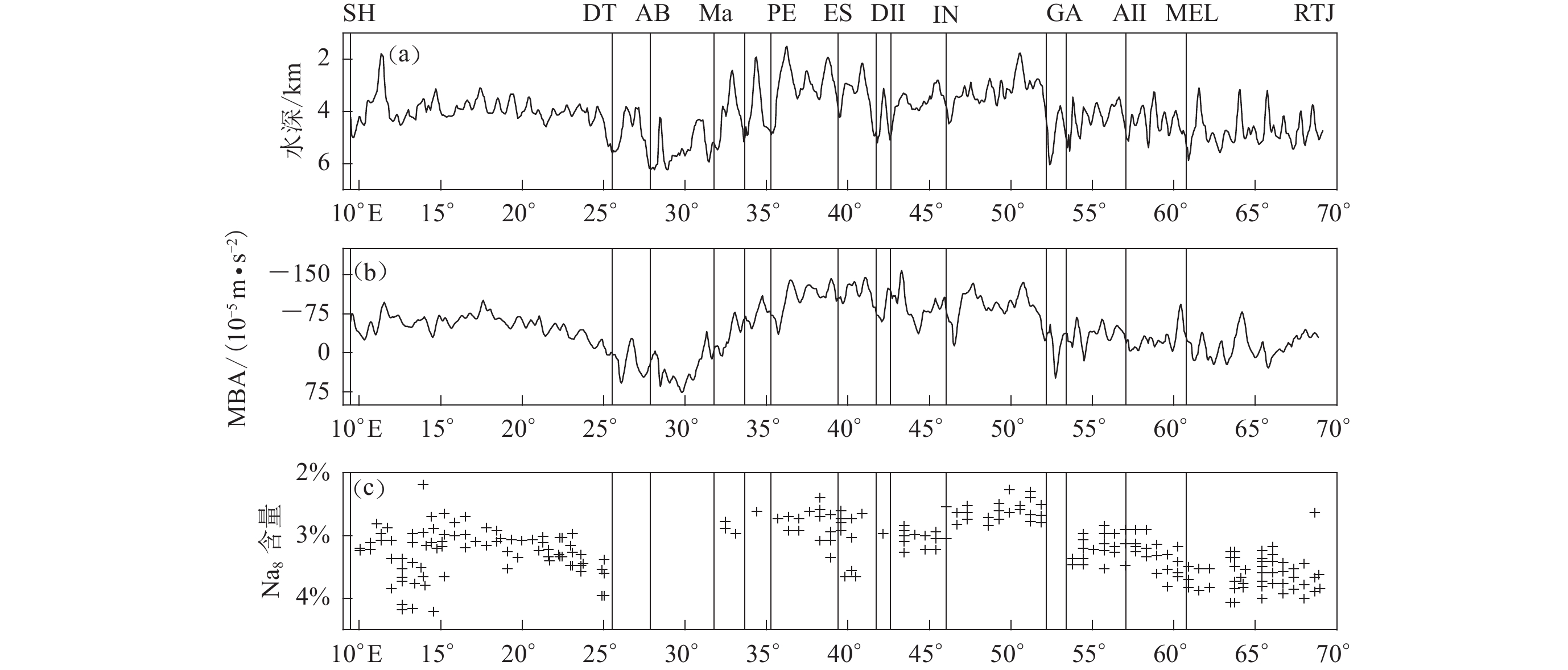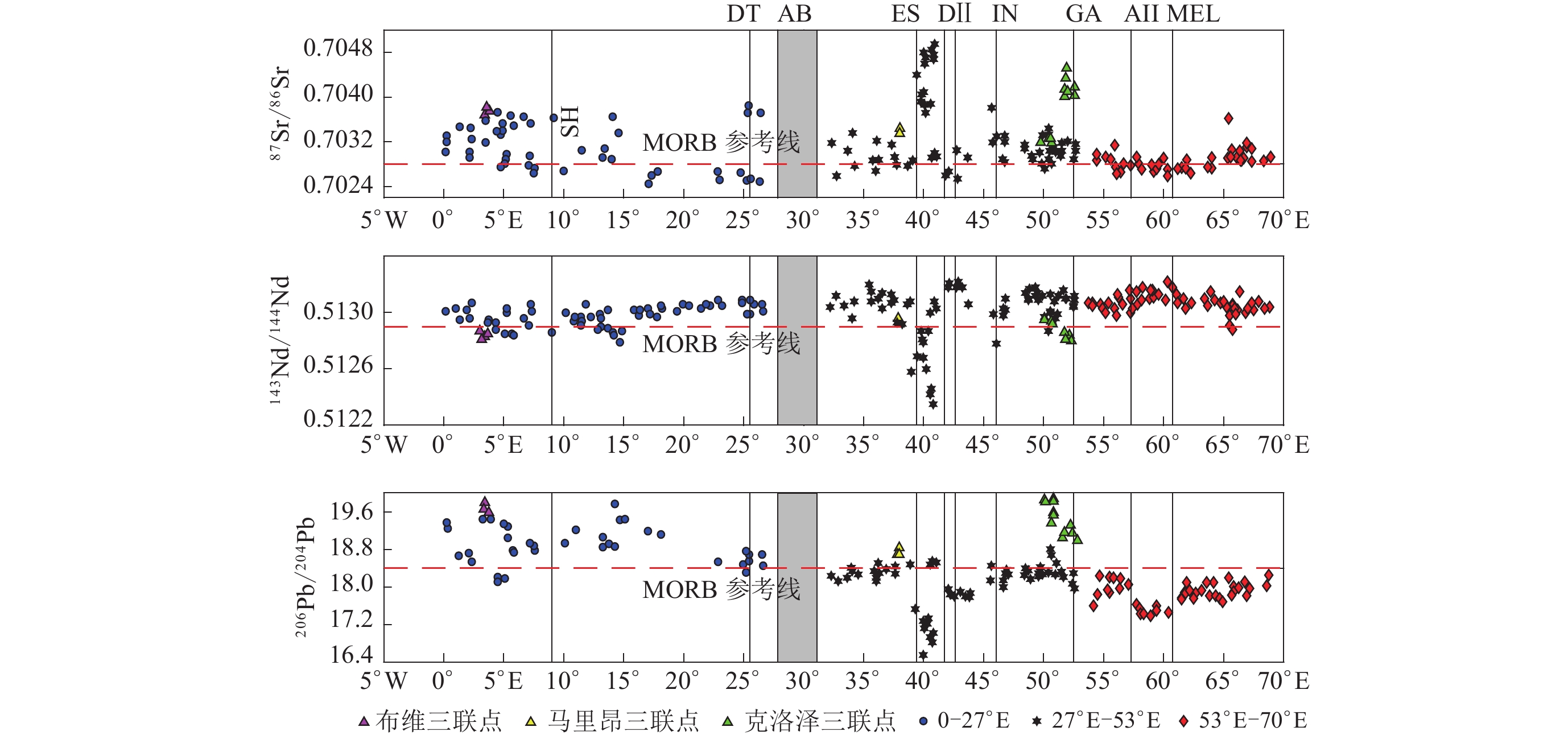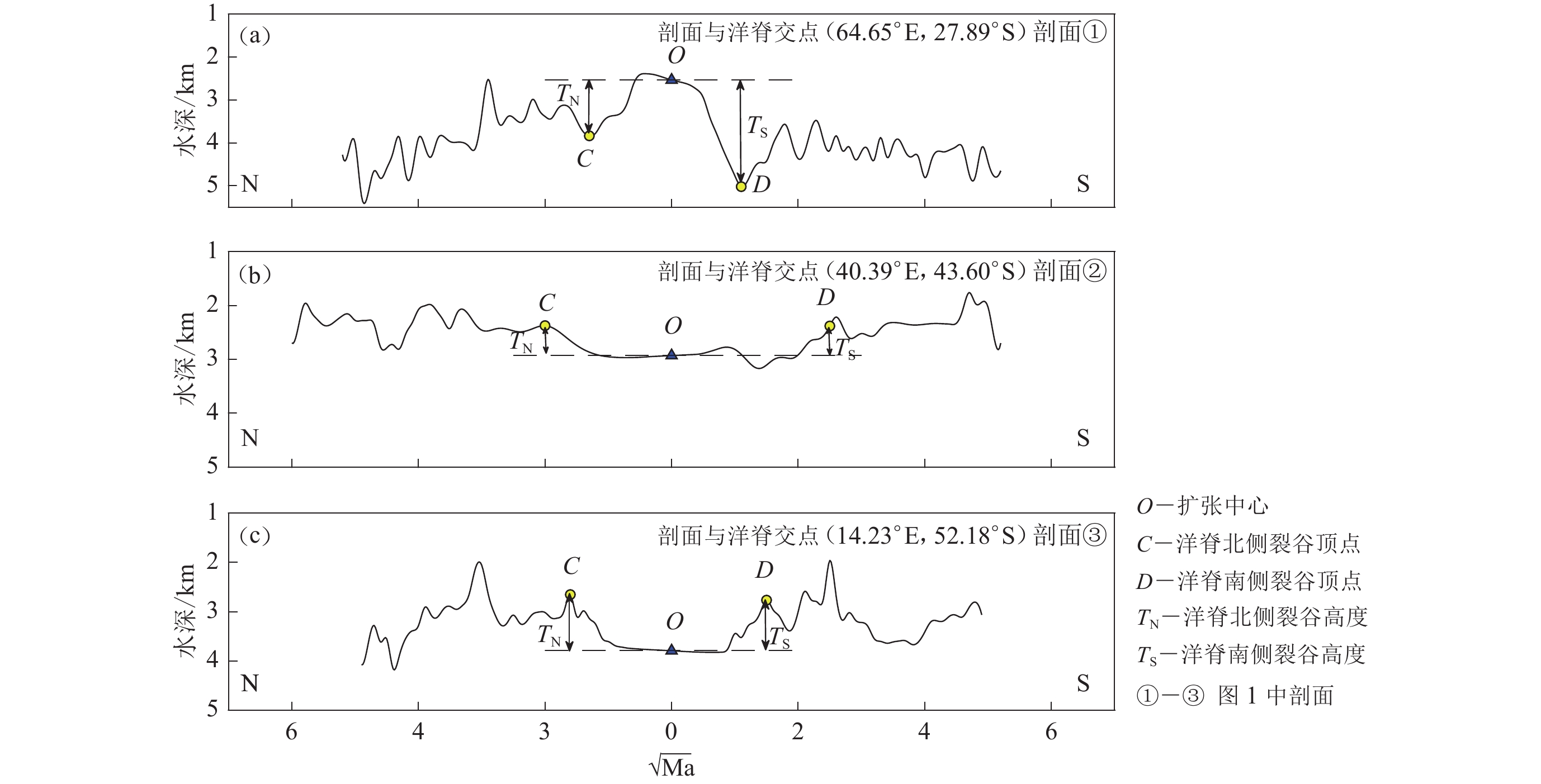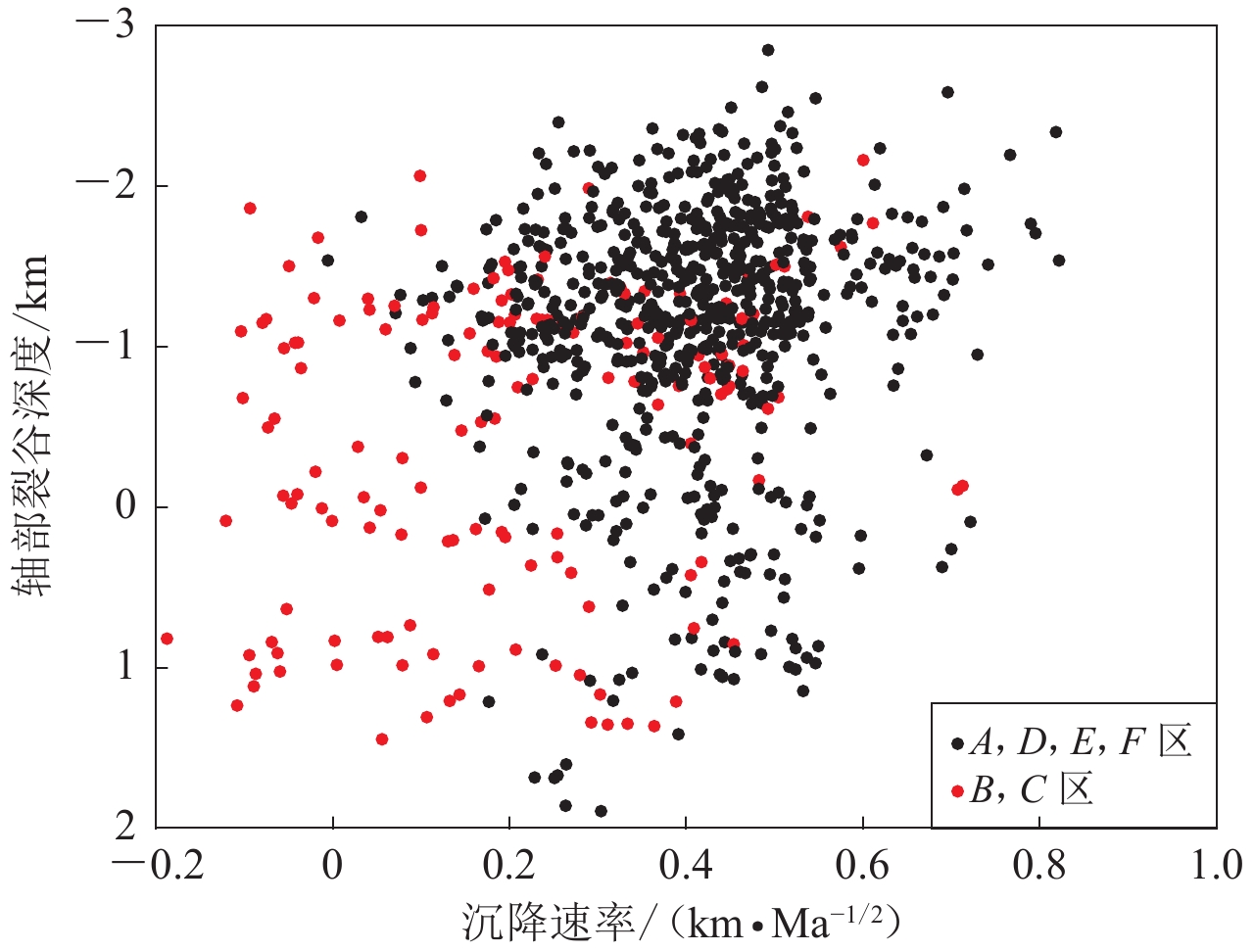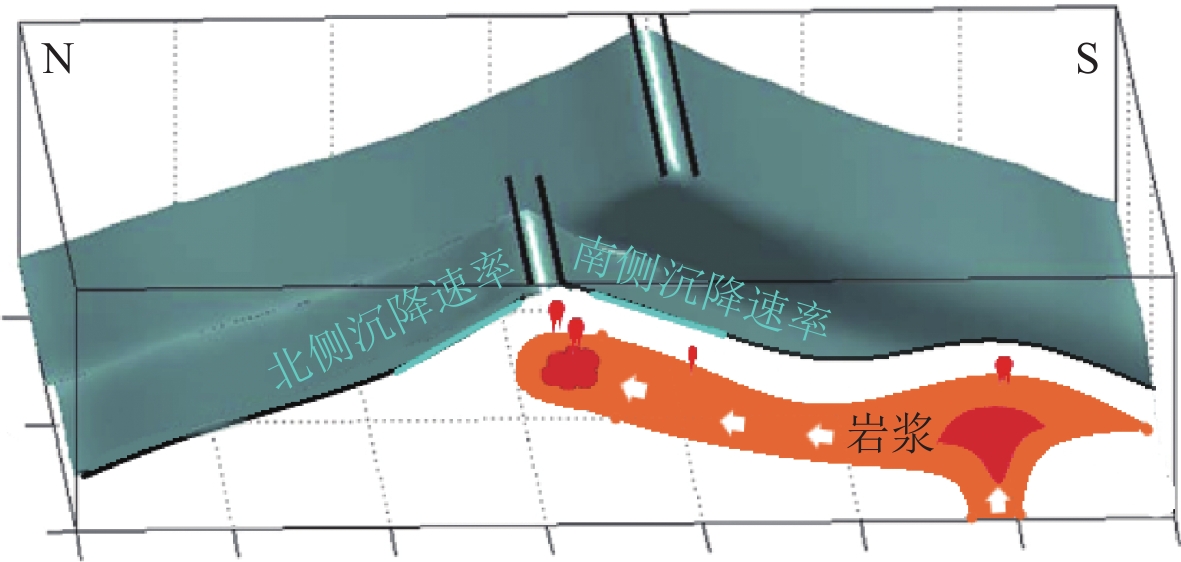Discussion on the interaction between hot spots and mid-ocean ridge from the axial morphology and the variation of subsidence rate on both sides of the Southwest Indian Ridge
-
摘要: 基于高精度地形数据,将西南印度洋中脊(11.88°E—66.75°E)分为6个区域,按不同区域分析洋脊轴部形态及其两侧基底沉降曲线的变化,由此探讨西南印度洋中脊的岩浆活动及其受热点影响的机制。结果显示:① 对于整个西南印度洋中脊,轴部隆起占13.38%,轴部裂谷占82.8%,平坦过渡形占3.82%,其中19°E,36°E,41.2°E,43.7°E,50.4°E和64.5°E等处为较集中的洋脊轴部隆起;② 埃里克辛普森—英多姆转换断层之间的区域(39.4°E—45.77°E)显示出异常浅的轴部裂谷和异常小且南北不对称的基底沉降速率,这表明埃里克辛普森—英多姆转换断层之间的区域是热点对洋中脊影响较为明显的区域,南侧较北侧异常小的基底沉降速率表明热点与洋中脊的相互作用主要表现为热点岩浆从洋中脊南部向上流动到岩石圈底部,然后与岩石圈发生相互作用。
-
关键词:
- 西南印度洋中脊 /
- 洋中脊轴部形态 /
- 基底沉降曲线 /
- 热点与洋中脊相互作用
Abstract: Based on high resolution seafloor bathymetry map, we divided the Southwest Indian Ridg (SWIR) (11.88°E—66.75°E) into six regions. In each region, we estimate the variation of the axial morphology, and the basement subsidence curve over the flanks of the spreading ridge, which can be used to indicate the spreading process of the SWIR and how it was affected by the hot spot. The result shows that: ① For the entire SWIR, axial uplift accounts for 13.38%, axial rift accounts for 82.8%, and flat transitional shape accounts for 3.82%, the areas at 19°E, 36°E, 41.2°E, 43.7°E, 50.4°E, 64.5°E have focus magmatic ridge representing axial ridge uplift; ② The area between the Eric Simpson-Indomed transition faults (39.4°E—45.77°E) shows axial valley with anomalous shallow bathymetry and asymmetrical anomalous low basement subsidence rates between north and south. Therefore, we believe that the area between the Eric Simpson-Indomed transition faults has been significantly affected by the hot spots. Compared with the subsidence rate north of the spreading ridge, the anomalous low subsidence rate in the south indicates that the interaction between the hot spots and the ridge is characterized by the hot spots flowing upward from the south of the SWIR to the bottom of the lithosphere, and then interact with the lithosphere. -
-
图 1 西南印度洋地形图及分区
SWIR:西南印度洋中脊;SEIR:东南印度洋中脊;CIR:中印度洋中脊;BTJ:布维三连点;RTJ:罗得里格斯三连点;SH:沙卡;DT:迪图瓦;AB:安德鲁贝恩;M:马里昂;PE:爱德华王子;ES:埃里克辛普森;DII:发现Ⅱ号;IN:英多姆;GA:加列尼;AII:亚特兰提斯Ⅱ号;MEL:梅尔。下同
Figure 1. Topographic map of Southwest Indian Ocean
SWIR:Southwest Indian Ridge;SEIR:Southeast Indian Ridge;CIR:Central Indian Ridge;BTJ:Bouvet Triple Junction;RTJ:Rodriguez Triple Junction;SH:Shaka;DT:Du Toit;AB:Andrew Bain;M:Marion;PE:Prince Edward;ES:Eric Simpson;DII:Discovery Ⅱ ;IN:Indomed;GA:Gallieni;AII:Atlantis Ⅱ ;MEL:Melville. The same below
图 2 SWIR沿轴水深、地幔布格重力异常MBA和玄武岩Na8含量变化图(修改自Sauter,Cannat,2010)
图中纵向灰色实线为转换断层位置。(a) 沿轴水深;(b) 沿轴MBA变化(Georgen et al,2001);(c) 玄武岩Na8含量变化
Figure 2. Variation of the depth,MBA,Na8 composition of basalts along the SWIR axis(modified after Sauter,Cannat,2010)
The vertical gray solid line indicates the location of transform faults. (a) Depth;(b) Mantle Bouguer anomaly (Georgen et al,2001); (c) Na8 composition of basalts
图 3 西南印度洋中脊玄武岩同位素比值变化图(修改自孙国洪等,2021)
Figure 3. Variations in isotopic ratios of MORBs along SWIR (modified after Sun et al,2021)
图 4 沿西南印度洋中脊的水深拟合图
红色实线为最佳高斯拟合线;灰色条带为转换断层发育位置;红色条带为热点投影到洋中脊的位置;A,B,C,D,E,F为洋脊研究分区
Figure 4. Fitting diagram of seafloor depth along SWIR
The solid red line is the best Gaussian fitting line;the gray stripes indicate the location of transition faults;the red stripe is the location where the plume is projected onto the mid-ocean ridge; A,B,C,D,E,F are the segmented study areas
图 5 沿西南印度洋中脊采样以及扩张方向示意图
(a) 水深地形图;(b) 磁异常分布图,磁异常数据来源于全球2′分辨率磁力网格数据EMAG2 (Maus et al,2009)
Figure 5. Schematic diagram of sampling along SWIR and its spreading direction
(a) Topographic map;(b) The magnetic anomalies map,and the magnetic anomaly data are from EMAG2 (Maus et al,2009)
图 10 SWIR沉降速率图
图(a)中红色实线为各研究区域内沉降速率的拟合线,品红色虚线为SWIR沉降速率平均值,蓝色阴影为全球沉降速率均值范围(Stein,Stein,1992;Crosby,McKenzie,2009);图(b)中蓝色和黑针线分别为洋中脊北侧沉降速率减去南侧所得的正值与负值,灰色及红色条带与图4同。顶部红色区域显示洋脊轴部隆起所占比例(a) 沉降速率沿轴变化图;(b) 洋脊两侧沉降速率差值沿轴变化图
Figure 10. SWIR sedimentation rate diagram
In fig.(a),the solid red line is the best fit line of the subsidence rate along the SWIR, the red dotted line shows an average SWIR subsidence rate,while the horizontal blue stripes represent the global subsidence rate (Stein, Stein,1992;Crosby,McKenzie,2009);In fig.(b),the black and blue lines indicate the values of difference between the northern and southern subsidence rate. The vertical gray and red stripes indicate the same meaning as in fig.4. The red areas at top represent the percentage of the axial rise for each region. (a) Subsidence rate variation along SWIR;(b) Axial variation of the difference between northern and southern subsidence rate
表 1 SWIR各研究区域的扩张轴部深度及沉降速率均值表
Table 1 Axial valley depth and subsidence rate of each area in SWIR
各研究分区 轴部裂谷深度/km 沉降速率/(km·Ma−1/2) A区 −1.09 0.393 B区 −0.48 0.244 C区 −0.37 0.129 D区 −0.95 0.407 E区 −1.40 0.420 F区 −1.14 0.414 SWIR −1.00 0.368 -
胡昊. 2020. 用OBS远震接收函数方法研究西南印度洋中脊深部结构及洋脊-热点相互作用[D]. 杭州: 浙江大学: 94–99. Hu H. 2020. Using OBS Teleseismic Receiver Function to Study the Deep Structure of the Southwest Indian Ridge and Interaction of the Ridge-Hotspot System[D]. Hangzhou: Zhejiang University: 94–99 (in Chinese).
李三忠,索艳慧,余珊,赵淑娟,戴黎明,曹花花,张臻,刘为勇,张国堙. 2015. 西南印度洋构造地貌与构造过程[J]. 大地构造与成矿学,39(1):15–29. doi: 10.3969/j.issn.1001-1552.2015.01.002 Li S Z,Suo Y H,Yu S,Zhao S J,Dai L M,Cao H H,Zhang Z,Liu W Y,Zhang G Y. 2015. Morphotectonics and tectonic processes of the southwest Indian Ocean[J]. Geotectonica et Metallogenia,39(1):15–29 (in Chinese).
刘持恒,李江海,张华添,刘仲兰,范庆凯. 2018. 西南印度洋岩浆补给特征研究:来自洋壳厚度的证据[J]. 地球物理学报,61(7):2859–2870. Liu C H,Li J H,Zhang H T,Liu Z L,Fan Q K. 2018. Magma supply of the southwest Indian Ocean:Evidence from crustal thickness anomalies[J]. Chinese Journal of Geophysics,61(7):2859–2870 (in Chinese).
孙国洪,田丽艳,李小虎,张汉羽,陈凌轩,刘红玲. 2021. 西南印度洋中脊岩石地球化学特征及其岩浆作用研究[J]. 海洋地质与第四纪地质,41(5):126–138. Sun G H,Tian L Y,Li X H,Zhang H Y,Chen L X,Liu H L. 2021. A review of studies on the magmatism at Southwest Indian Ridge from petrological and geochemical perspectives[J]. Marine Geology &Quaternary Geology,41(5):126–138 (in Chinese).
余星,迪克·亨利,李小虎,初凤友,董彦辉,胡航. 2020. 西南印度洋中脊地质构造特征及其地球动力学意义[J]. 地球物理学报,63(10):3585–3603. Yu X,Dick H,Li X H,Chu F Y,Dong Y H,Hu H. 2020. The geotectonic features of the Southwest Indian Ridge and its geodynamic implications[J]. Chinese Journal of Geophysics,63(10):3585–3603 (in Chinese).
Albers M,Christensen U R. 2001. Channeling of plume flow beneath mid-ocean ridges[J]. Earth Planet Sci Lett,187(1/2):207–220.
Anderson M O,Chadwick Jr W W,Hannington M D,Merle S G,Resing J A,Baker E T,Butterfield D A,Walker S L,Augustin N. 2017. Geological interpretation of volcanism and segmentation of the Mariana back-arc spreading center between 12.7°N and 18.3°N[J]. Geochem,Geophys,Geosyst,18(6):2240–2274.
Baines A G,Cheadle M J,Dick H J B,Scheirer A H,John B E,Kusznir N J,Matsumoto T. 2007. Evolution of the Southwest Indian Ridge from 55°45′E to 62°E:Changes in plate-boundary geometry since 26 Ma[J]. Geochem,Geophys,Geosyst,8(6):Q06022.
Buck W R,Lavier L L,Poliakov A N B. 2005. Modes of faulting at mid-ocean ridges[J]. Nature,434(7034):719–723. doi: 10.1038/nature03358
Cannat M,Rommevaux-Jestin C,Sauter D,Deplus C,Mendel V. 1999. Formation of the axial relief at the very slow spreading Southwest Indian Ridge (49° to 69°E)[J]. J Geophys Res:Solid Earth,104(B10):22825–22843. doi: 10.1029/1999JB900195
Chen Y S,Morgan W J. 1990a. A nonlinear rheology model for mid-ocean ridge axis topography[J]. J Geophys Res,95(B11):17583–17604. doi: 10.1029/JB095iB11p17583
Chen Y S,Morgan W J. 1990b. Rift valley/no rift valley transition at mid-ocean ridges[J]. J Geophys Res:Solid Earth,95(B11):17571–17581. doi: 10.1029/JB095iB11p17571
Crosby A G,McKenzie D. 2009. An analysis of young ocean depth,gravity and global residual topography[J]. Geophys J Int,178(3):1198–1219. doi: 10.1111/j.1365-246X.2009.04224.x
Dick H J B,Lin J,Schouten H. 2003. An ultraslow-spreading class of ocean ridge[J]. Nature,426(6965):405–412. doi: 10.1038/nature02128
Dutkiewicz A,Müller R D,Wang X,O’Callaghan S,Cannon J,Wright N M. 2017. Predicting sediment thickness on vanished ocean crust since 200 Ma[J]. Geochem,Geophys,Geosyst,18(12):4586–4603.
Font L,Murton B J,Roberts S,Tindle A G. 2007. Variations in melt productivity and melting conditions along SWIR (70°E–49°E):Evidence from olivine-hosted and plagioclase-hosted melt inclusions[J]. J Petrol,48(8):1471–1494. doi: 10.1093/petrology/egm026
Gautheron C,Moreira M,Gerin C,Tassan-Got L,Bezos A,Humler E. 2015. Constraints on the DUPAL anomaly from helium isotope systematics in the Southwest Indian mid-ocean ridge basalts[J]. Chem Geol,417:163–172. doi: 10.1016/j.chemgeo.2015.10.005
Georgen J E,Lin J,Dick H J B. 2001. Evidence from gravity anomalies for interactions of the Marion and Bouvet hotspots with the Southwest Indian Ridge:Effects of transform offsets[J]. Earth Planet Sci Lett,187(3/4):283–300.
Georgen J E. 2014. Interaction of a mantle plume and a segmented mid-ocean ridge:Results from numerical modeling[J]. Earth Planet Sci Lett,392:113–120. doi: 10.1016/j.jpgl.2014.01.035
Hirth G,Kohlstedt D L. 1996. Water in the oceanic upper mantle:Implications for rheology,melt extraction and the evolution of the lithosphere[J]. Earth Planet Sci Lett,144(1/2):93–108.
Ito G,Shen Y,Hirth G,Wolfe C J. 1999. Mantle flow,melting,and dehydration of the Iceland mantle plume[J]. Earth Planet Sci Lett,165(1):81–96. doi: 10.1016/S0012-821X(98)00216-7
Jian H C,Singh S C,Chen Y J,Li J B. 2017a. Evidence of an axial magma chamber beneath the ultraslow-spreading Southwest Indian Ridge[J]. Geology,45(2):143–146. doi: 10.1130/G38356.1
Jian H C,Chen Y J,Singh S C,Li J B,Zhao M H,Ruan A G,Qiu X L. 2017b. Seismic structure and magmatic construction of crust at the ultraslow-spreading Southwest Indian Ridge at 50°28′E[J]. J Geophys Res:Solid Earth,122(1):18–42. doi: 10.1002/2016JB013377
Li J B,Jian H C,Chen Y J,Singh S C,Ruan A G,Qiu X L,Zhao M H,Wang X G,Niu X W,Ni J Y,Zhang J Z. 2015. Seismic observation of an extremely magmatic accretion at the ultraslow spreading Southwest Indian Ridge[J]. Geophys Res Lett,42(8):2656–2663. doi: 10.1002/2014GL062521
Lin J,Parmentier E M. 1989. Mechanisms of lithospheric extension at mid-ocean ridges[J]. Geophys J Int,96(1):1–22. doi: 10.1111/j.1365-246X.1989.tb05246.x
Lin J,Purdy G M,Schouten H,Sempere J C,Zervas C. 1990. Evidence from gravity data for focused magmatic accretion along the Mid-Atlantic Ridge[J]. Nature,344(6267):627–632. doi: 10.1038/344627a0
Marks K M,Stock J M. 1994. Variations in ridge morphology and depth-age relationships on the Pacific-Antarctic Ridge[J]. J Geophys Res:Solid Earth,99(B1):531–541. doi: 10.1029/93JB02760
Maus S,Barckhausen U,Berkenbosch H,Bournas N,Brozena J,Childers V,Dostaler F,Fairhead J D,Finn C,von Frese R R B,Gaina C,Golynsky S,Kucks R,Lühr H,Milligan P,Mogren S,Müller R D,Olesen O,Pilkington M,Saltus R,Schreckenberger B,Thébault E,Caratori Tontini F. 2009. EMAG2:A 2–arc min resolution Earth Magnetic Anomaly Grid compiled from satellite,airborne,and marine magnetic measurements[J]. Geochem,Geophys,Geosyst,10(8):Q08005.
McDougall I A N,Verwoerd W,Chevallier L U C. 2001. K-Ar geochronology of Marion Island,Southern Ocean[J]. Geol Mag,138(1):1–17. doi: 10.1017/S0016756801005039
McKenzie D P. 1967. Some remarks on heat flow and gravity anomalies[J]. J Geophys Res,72(24):6261–6273. doi: 10.1029/JZ072i024p06261
Mendel V, Sauter D, Rommevaux-Jestin C, Patriat P, Lefebvre F, Parson L M. 2003. Magmato-tectonic cyclicity at the ultra-slow spreading Southwest Indian Ridge: Evidence from variations of axial volcanic ridge morphology and abyssal hills pattern[J]. Geochem, Geophys, Geosyst, 4(5): 9102.
Meyzen C M, Ludden J N, Humler E, Luais B, Toplis M J, Mével C, Storey M. 2005. New insights into the origin and distribution of the DUPAL isotope anomaly in the Indian Ocean mantle from MORB of the Southwest Indian Ridge[J]. Geochem, Geophys, Geosyst, 6(11): Q11K11.
Minshull T A,Muller M R,White R S. 2006. Crustal structure of the Southwest Indian Ridge at 66°E:Seismic constraints[J]. Geophys J Int,166(1):135–147. doi: 10.1111/j.1365-246X.2006.03001.x
Muller M R,Robinson C J,Minshull T A,White R S,Bickle M J. 1997. Thin crust beneath ocean drilling program borehole 735B at the Southwest Indian Ridge?[J]. Earth Planet Sci Lett,148(1/2):93–107.
Muller M R,Minshull T A,White R S. 2000. Crustal structure of the Southwest Indian Ridge at the Atlantis II fracture zone[J]. J Geophys Res:Solid Earth,105(B11):25809–25828. doi: 10.1029/2000JB900262
Niu X W,Ruan A G,Li J B,Minshull T A,Sauter D,Wu Z L,Qiu X L,Zhao M H,Chen Y J,Singh S. 2015. Along-axis variation in crustal thickness at the ultraslow spreading Southwest Indian Ridge (50°E) from a wide-angle seismic experiment[J]. Geochem,Geophys,Geosyst,16(2):468–485.
Parson B,Sclater J G. 1997. An analysis of the variation of ocean floor bathymetry and heat flow with age[J]. J Geophys Res,82(5):803–827.
Patriat P,Sloan H,Sauter D. 2008. From slow to ultraslow:A previously undetected event at the Southwest Indian Ridge at ca. 24 Ma[J]. Geology,36(3):207–210. doi: 10.1130/G24270A.1
Ruan A G,Hu H,Li J B,Niu X W,Wei X D,Zhang J,Wang A X. 2017. Crustal structure and mantle transition zone thickness beneath a hydrothermal vent at the ultra-slow spreading Southwest Indian Ridge (49°39′E):A supplementary study based on passive seismic receiver functions[J]. Mar Geophys Res,38(1):39–46.
Sauter D,Patriat P,Rommevaux-Jestin C,Cannat M,Briais A,Gallieni Shipboard Scientific Party. 2001. The Southwest Indian Ridge between 49°15′E and 57°E:Focused accretion and magma redistribution[J]. Earth Planet Sci Lett,192(3):303–317. doi: 10.1016/S0012-821X(01)00455-1
Sauter D, Carton H, Mendel V, Munschy M, Rommevaux-Jestin C, Schott J J, Whitechurch H. 2004. Ridge segmentation and the magnetic structure of the Southwest Indian Ridge (at 50°30′E, 55°30′E and 66°20′E): Implications for magmatic processes at ultraslow-spreading centers[J]. Geochem, Geophys, Geosyst, 5(5): Q05K08.
Sauter D,Cannat M,Meyzen C,Bezos A,Patriat P,Humler E,Debayle E. 2009. Propagation of a melting anomaly along the ultraslow Southwest Indian Ridge between 46°E and 52°20′E:Interaction with the Crozet hotspot?[J]. Geophys J Int,179(2):687–699. doi: 10.1111/j.1365-246X.2009.04308.x
Sauter D, Cannat M. 2010. The ultraslow spreading Southwest Indian ridge[G]//Diversity of Hydrothermal Systems on Slow Spreading Ocean Ridges. Washington: American Geophysical Union: 153–173.
Sauter D,Cannat M,Rouméjon S,Andreani M,Birot D,Bronner A,Brunelli D,Carlut J,Delacour A,Guyader V,MacLeod C J,Manatschal G,Mendel V,Ménez B,Pasini V,Ruellan E,Searle R. 2013. Continuous exhumation of mantle-derived rocks at the Southwest Indian Ridge for 1 1 million years[J]. Nat Geosci,6(4):314–320. doi: 10.1038/ngeo1771
Scripps Institution of Oceanography, University of California San Diego. 2023. Index of /pub/archive/srtm15/V1[EB/OL]. [2022-08-23]. https://topex.ucsd.edu/pub/archive/srtm15/V1/
Seton M, Müller R D, Zahirovic S, Williams S, Wright N M, Cannon J, Whittaker J M, Matthews K J, McGirr R. 2020. A global data set of present-day oceanic crustal age and seafloor spreading parameters[J]. Geochem, Geophys, Geosyst, 21(10): e2020GC009214.
Sloan H,Sauter D,Goff J A,Cannat M. 2012. Abyssal hill characterization at the ultraslow spreading Southwest Indian Ridge[J]. Geochem,Geophys,Geosyst,13(2):Q0AE06.
Stein C A,Stein S. 1992. A model for the global variation in oceanic depth and heat flow with lithospheric age[J]. Nature,359(6391):123–129. doi: 10.1038/359123a0
Storey M,Mahoney J J,Saunders A D,Duncan R A,Kelley S P,Coffin M F. 1995. Timing of hot spot-related volcanism and the breakup of Madagascar and India[J]. Science,267(5199):852–855. doi: 10.1126/science.267.5199.852
Tao C H,Lin J,Guo S Q,Chen Y J,Wu G H,Han X Q,German C R,Yoerger D R,Zhou N,Li H M,Su X,Zhu J,the DY115-19 (Legs 1–2) and DY115-20 (Legs 4–7) Science Parties. 2012. First active hydrothermal vents on an ultraslow-spreading center:Southwest Indian Ridge[J]. Geology,40(1):47–50. doi: 10.1130/G32389.1
Tapponnier P,Francheteau J. 1978. Necking of the lithosphere and the mechanics of slowly accreting plate boundaries[J]. J Geophys Res:Solid Earth,83(B8):3955–3970. doi: 10.1029/JB083iB08p03955
Turcotte D L,Oxburgh E R. 1969. Convection in a mantle with variable physical properties[J]. J Geophys Res,74(6):1458–1474. doi: 10.1029/JB074i006p01458
Vogt P R,Johnson G L. 1975. Transform faults and longitudinal flow below the Midoceanic Ridge[J]. J Geophys Res,80(11):1399–1428. doi: 10.1029/JB080i011p01399
Wessel P, Smith W H F. 1995. New version of the generic mapping tools[J]. Eos, Trans Am Geophys Union, 76(33): 329.
White R S,McKenzie D,O’Nions R K. 1992. Oceanic crustal thickness from seismic measurements and rare earth element inversions[J]. J Geophys Res:Solid Earth,97(B13):19683–19715. doi: 10.1029/92JB01749
Whittaker J M,Goncharov A,Williams S E,Müller R D,Leitchenkov G. 2013. Global sediment thickness data set updated for the Australian-Antarctic Southern Ocean[J]. Geochem,Geophys,Geosyst,14(8):3297–3305.
Yale M M,Morgan J P. 1998. Asthenosphere flow model of hotspot-ridge interactions:A comparison of Iceland and Kerguelen[J]. Earth Planet Sci Lett,161(1/2/3/4):45–56.
Yang A Y,Zhao T P,Zhou M F,Deng X G. 2017. Isotopically enriched N-MORB:A new geochemical signature of off-axis plume-ridge interaction:A case study at 50°28′E,Southwest Indian Ridge[J]. J Geophys Res:Solid Earth,122(1):191–213.
Zhang T,Lin J,Gao J Y. 2011. Interactions between hotspots and the Southwest Indian Ridge during the last 90 Ma:Implications on the formation of oceanic plateaus and intra-plate seamounts[J]. Science China Earth Sciences,54(8):1177–1188. doi: 10.1007/s11430-011-4219-9
Zhang T,Lin J,Gao J Y. 2013. Magmatism and tectonic processes in Area A hydrothermal vent on the Southwest Indian Ridge[J]. Science China Earthquake Science,56(12):2186–2197. doi: 10.1007/s11430-013-4630-5
Zhao M H,Qiu X L,Li J B,Sauter D,Ruan A G,Chen J,Cannat M,Singh S,Zhang J Z,Wu Z L,Niu X W. 2013. Three-dimensional seismic structure of the Dragon Flag oceanic core complex at the ultraslow spreading Southwest Indian Ridge (49°39′E)[J]. Geochem,Geophys,Geosyst,14(10):4544–4563.





 下载:
下载:

